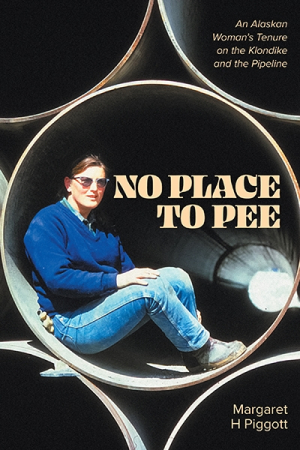No Place to Pee
An Alaskan Woman's Tenure on the Klondike and the Pipeline
No Place to Pee is an engaging memoir about time spent working in construction in Alaska, and as a rare woman on the team.
Margaret H. Piggott’s memoir No Place to Pee is about being a lone woman laborer on the Alaskan frontier.
Piggott spent several years doing manual labor in the 1970s, first on the Klondike Highway and then on the Trans-Alaska Pipeline. This book recounts that time, drawing on the journals that Piggott kept in the moment. Honest and gritty, it discusses what it was like to be the only woman on work crews, where she faced ambivalence: some recognized her hard work; others discriminated against her, refusing to accept that a woman could succeed at “man’s work.” Piggott’s challenging, even backbreaking jobs are described with wisdom that draws on her training as a physical therapist.
The journal entries’ in-the-moment observations are adapted in the book, whose pace ebbs and flows. In intense moments, it is detail-heavy, covering the minutiae of Piggott’s projects; longer periods of repetitive activities are condensed. Piggott’s sense of place is strong: she captures Alaska as beautiful and isolated, covering both the history of what came before her work, and of what the construction projects led to.
As a narrator, Piggott holds reverence for both parts of the land’s history, remarking on the importance of the animals and Indigenous people, but also discussing Alaska’s future, and what increased connectivity and industry might mean for its communities. While her work was not typical conservationist work, Piggott entered into it with a naturalist’s appreciation and values. She made sure that the brush-clearing fires for the highway didn’t damage the forest, and on the pipeline she kept a keen eye on the wildlife—“play[ing] watchdog—from the inside.”
Open and hopeful in tone, despite the frustrations and hard work it relates, this is a book that conveys the enjoyment that can be drawn from solitary work. Piggott expresses that she formed a closer connection to herself as she worked, while also deepening her appreciation for the relationships in her life, including with a host and mentor. Photographs augment her stories, capturing Piggott herself, wildlife, and the construction projects’ progress; intriguing sketches from the original journals are included, with maps, plans, and musings found among them.
No Place to Pee is an engaging memoir about time spent working in construction in Alaska, and as a rare woman on the team.
Reviewed by
Melissa Wuske
Disclosure: This article is not an endorsement, but a review. The publisher of this book provided free copies of the book and paid a small fee to have their book reviewed by a professional reviewer. Foreword Reviews and Clarion Reviews make no guarantee that the publisher will receive a positive review. Foreword Magazine, Inc. is disclosing this in accordance with the Federal Trade Commission’s 16 CFR, Part 255.

